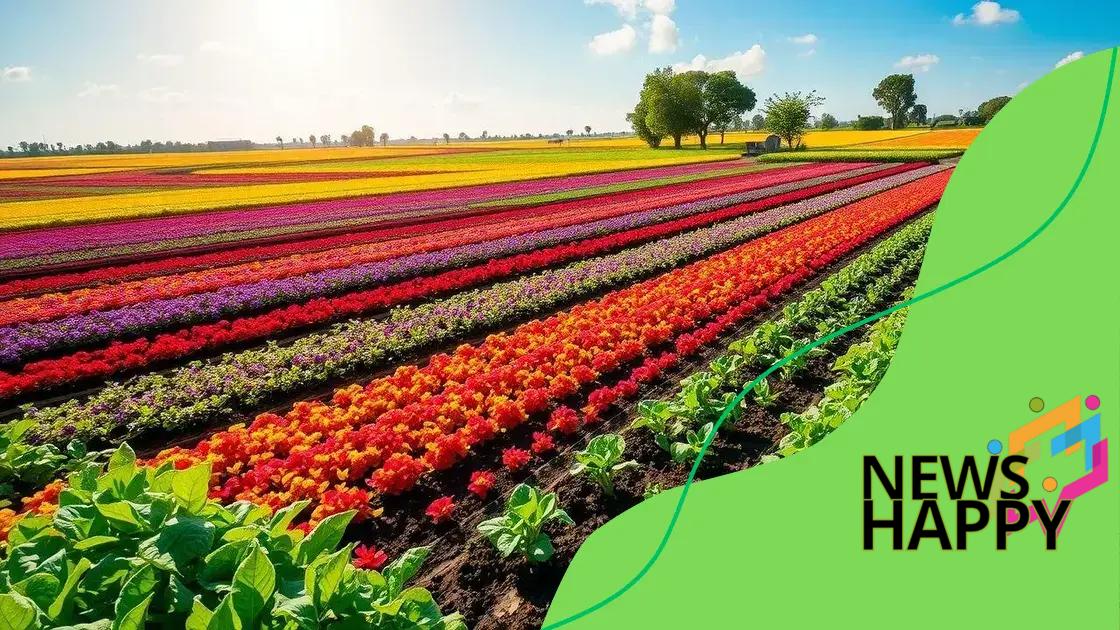Investing in sustainable agriculture for long-term growth

Anúncios
Investing in sustainable agriculture focuses on implementing eco-friendly practices that enhance productivity, protect ecosystems, and ensure food security for future generations.
Investing in sustainable agriculture for long-term growth is not just a trend—it’s a necessity. Have you ever wondered how our food systems can be both productive and environmentally sound? This article dives into the various aspects of sustainable farming, helping you understand its importance for the future.
Anúncios
Understanding sustainable agriculture
Understanding sustainable agriculture is key to fostering a food system that benefits the planet and its people. This approach emphasizes practices that support environmental health, economic viability, and social equity.
Sustainable agriculture is all about finding balance. By focusing on eco-friendly practices, we can ensure that we produce enough food for future generations while protecting our natural resources. Whether you are a farmer or a consumer, knowing how sustainable practices work can empower better choices.
Core Principles of Sustainable Agriculture
There are several principles that guide sustainable agriculture:
Anúncios
- Promotes soil health through organic practices.
- Reduces chemical use that harms the environment.
- Boosts biodiversity to prevent pests and diseases.
- Encourages water conservation through efficient practices.
Adopting these principles leads to healthier crops and a more resilient farming system. The idea is not just to produce more but to do so in a way that safeguards our resources and supports our communities.
Benefits of Sustainable Practices
When we invest in sustainable agriculture, the benefits can be widespread:
- Improved soil quality enhances crop yields.
- Better resilience to climate change leads to more stable food supplies.
- Economic opportunities arise in local communities through eco-friendly farming initiatives.
Exploring these benefits provides insight into why we must shift towards sustainable methods in agriculture. By underscoring the importance of these practices, we can foster long-term growth that honors the earth.
Benefits of investing in sustainable practices
Investing in sustainable practices brings a myriad of benefits that extend far beyond individual farms. By adopting these practices, farmers and communities can experience a transformation in both economic and environmental health.
One major advantage is the enhancement of soil quality. Through methods like crop rotation and organic fertilization, farmers can create healthier soils that yield more productive crops. This not only boosts food production but also promotes biodiversity by fostering a variety of plant and animal life.
Economic Advantages
Investing in sustainable agriculture can lead to significant economic benefits. Communities that embrace these practices often see:
- Lower input costs, as sustainable methods can reduce the need for expensive chemicals.
- Increased market opportunities, with more consumers seeking eco-friendly products.
- Job creation in sectors supporting sustainable farming.
These factors contribute to stronger local economies and provide stability in uncertain times.
Environmental Impact
Another important benefit is the positive impact on the environment. Sustainable practices help mitigate climate change by:
- Reducing greenhouse gas emissions through less reliance on fossil fuels.
- Enhancing carbon sequestration in healthier soils.
- Protecting water sources from pollution and overuse.
By making these small changes, farmers are not only caring for their land but also ensuring a better future for generations to come.
Ultimately, investing in sustainable practices creates a cycle of benefits, wherein healthy ecosystems support resilient farming and communities thrive economically. With an increasing awareness of environmental issues, this investment is more crucial than ever.
Key strategies for sustainable farming

Implementing key strategies for sustainable farming is vital for producing food that maintains the ecosystem’s health. These strategies not only enhance crop yield but also protect the environment.
Farmers can utilize practices such as integrated pest management and regenerative agriculture. These methods minimize harm to the environment while maximizing productivity. Understanding how to apply these can lead to a thriving farm.
Crop Diversity
One effective strategy is maintaining crop diversity. By planting a variety of crops, farmers can:
- Enhance soil fertility and prevent nutrient depletion.
- Reduce the risk of pest and disease outbreaks.
- Promote a balanced ecosystem.
Mixing crops can also create resilience against climate change, ensuring that some plants thrive even under adverse conditions.
Soil Health Improvement
Another essential strategy involves improving soil health. Healthy soil supports robust plant growth and reduces the need for chemical fertilizers. Methods like cover cropping and minimal tillage are effective:
- Cover crops protect soil from erosion.
- They add organic matter and nutrients back into the earth.
- Reducing tillage maintains soil structure and moisture.
Healthy soil ultimately leads to healthier plants and better yields, which is crucial for sustainable practices.
Finally, adopting water conservation techniques, such as drip irrigation and rainwater harvesting, can greatly enhance sustainability. These methods ensure that water is used efficiently, benefiting both crops and the environment.
Challenges to consider in sustainable agriculture
While sustainable agriculture offers numerous benefits, there are also several challenges that must be addressed. Understanding these obstacles is crucial for farmers and stakeholders aiming to implement sustainable practices effectively.
One significant challenge is the initial cost of transitioning to sustainable methods. Many eco-friendly practices require investments in new technologies, seeds, or training. This can be especially tough for small farmers who operate on tight budgets.
Market Accessibility
Another challenge involves market access. Sustainable products may face competition from cheaper, conventionally-grown produce. Farmers need to find ways to market their sustainable goods effectively, which can include:
- Building relationships with local grocery stores.
- Participating in farmer’s markets.
- Utilizing online platforms to reach consumers directly.
By connecting with the right buyers, farmers can help bridge the gap between production and sales.
Weather Variability
Moreover, climate change brings about weather variability that can hinder sustainable practices. Farmers face unpredictable rainfall patterns, droughts, and other extreme weather events. These conditions complicate planning and can damage crops. Adapting to this new reality often requires innovation and resilience.
Lastly, another hidden challenge is the knowledge gap. Farmers may lack sufficient training on best practices for sustainable agriculture. Programs that provide education and resources are essential to empower farmers to adopt these methods successfully.
Recognizing and addressing these challenges is the first step toward building a more sustainable and resilient agricultural system. By understanding the hurdles, stakeholders can work together to find solutions that foster lasting change.
Future trends in sustainable agriculture
Future trends in sustainable agriculture indicate an exciting evolution in farming practices and food production. As the world grapples with climate change and resource scarcity, innovative approaches are emerging to ensure food security while protecting the Earth.
One important trend is the rise of precision agriculture. This technology uses data analytics and sensors to optimize crop management. Farmers can monitor soil health, weather conditions, and crop needs closely, leading to more efficient resource use.
Regenerative Agriculture
Another significant movement gaining traction is regenerative agriculture. This method focuses on restoring soil and ecosystems rather than just sustaining them. Practices include cover cropping and holistic grazing, which enhance soil health and biodiversity.
- Regenerative practices lead to improved water retention in soil.
- They help sequester carbon, reducing greenhouse gases.
- Such methods enhance resilience against climate change.
As these practices become more widespread, farmers can contribute to a healthier planet while boosting their productivity.
Vertical Farming
A growing trend being explored is vertical farming. By growing crops in stacked layers, often in urban settings, farmers can produce food closer to consumers. This method conserves space and water and reduces transportation emissions.
Moreover, advances in biotechnology are paving the way for crops that require fewer inputs or are more resilient to changing climates. This means farmers can reduce chemical use while maintaining yields. Furthermore, community-supported agriculture (CSA) movements are gathering momentum as consumers seek more local and fresh produce.
These future trends collectively point toward a more sustainable and resilient agricultural system. By embracing innovation, farmers can tackle the challenges of tomorrow while ensuring a sustainable food supply for future generations.
FAQ – Frequently Asked Questions about Investing in Sustainable Agriculture
What are the main benefits of sustainable agriculture?
Sustainable agriculture enhances soil health, boosts biodiversity, and reduces environmental impact, leading to a healthier ecosystem and food supply.
How can technology aid sustainable farming?
Technology, such as precision agriculture, helps farmers monitor resources and improve efficiency, minimizing waste and maximizing crop yields.
What challenges do farmers face when adopting sustainable practices?
Farmers may encounter high initial costs, market accessibility issues, and knowledge gaps regarding sustainable methods.
What future trends should we expect in sustainable agriculture?
Future trends include regenerative agriculture, vertical farming, and increased use of biotechnology to enhance resilience and productivity.





